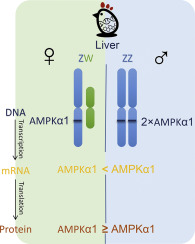当前位置:
X-MOL 学术
›
Comp. Biochem. Physiol. A Mol. Integr. Physiol.
›
论文详情
Our official English website, www.x-mol.net, welcomes your
feedback! (Note: you will need to create a separate account there.)
Effects of sex and fasting/refeeding on hepatic AMPK signaling in chickens (Gallus gallus).
Comparative Biochemistry and Physiology A: Molecular & Integrative Physiology ( IF 2.1 ) Pub Date : 2019-10-30 , DOI: 10.1016/j.cbpa.2019.110606 Yufeng Wang 1 , Johan Buyse 1 , Nathalie Courousse 2 , Sophie Tesseraud 2 , Sonia Métayer-Coustard 2 , Cécile Berri 2 , Seline Schallier 1 , Nadia Everaert 3 , Anne Collin 2
Comparative Biochemistry and Physiology A: Molecular & Integrative Physiology ( IF 2.1 ) Pub Date : 2019-10-30 , DOI: 10.1016/j.cbpa.2019.110606 Yufeng Wang 1 , Johan Buyse 1 , Nathalie Courousse 2 , Sophie Tesseraud 2 , Sonia Métayer-Coustard 2 , Cécile Berri 2 , Seline Schallier 1 , Nadia Everaert 3 , Anne Collin 2
Affiliation

|
The alpha-1 isoform of chicken AMPK situates on the Z-chromosome, in contrast, the other isoforms in birds and the mammalian AMPKα1 are located on the autosomes. The present study aimed to investigate the role of hepatic AMPK signaling in adaptation to nutritional status and the potential sex-specific response in chickens. Hepatic genes and proteins were compared between the two sexes immediately after hatching. From 20d of age, chicks from each sex received feed treatments: Control was fed ad libitum; Fasted was starved for 24 h; Refed was fed for 4 h after a 24 h fasting. As a result, hepatic AMPKα1 mRNA level in males was significantly higher at both ages compared to females, due to the presence of Z-chromosomes. However, this did not make this kinase "male-bias" as it was eventually compensated at a translational level, which was not reported in previous studies. The protein levels and activation of AMPKα were even lower in newly-hatched male compared to female chicks, accompanied with a higher FAS and SREBP-1 gene expressions. Accordingly, hepatic G6PC2 mRNA levels in males were significantly lower associated with lower plasma glucose levels after hatching. Fasting activated hepatic AMPK, which in turn inhibited gene expression of GS, FAS and SREBP-1, and stimulated the downstream G6PC2 in both sexes. These changes recovered after refeeding. In conclusion, AMPK plays a role in adaptation to nutritional environment for both sexes. The Z-linked AMPK did not exert a sex-specific signaling, due to a "translational compensation" of AMPKα1.
中文翻译:

性别和禁食/进食对鸡(鸡鸡)肝脏AMPK信号的影响。
鸡AMPK的α-1亚型位于Z染色体上,相反,鸟类中的其他亚型和哺乳动物AMPKα1位于常染色体上。本研究旨在调查肝脏AMPK信号在适应鸡的营养状况和潜在的性别特异性反应中的作用。孵化后立即比较两个性别之间的肝基因和蛋白质。从20日龄开始,各性别的雏鸡都接受饲料处理:随意喂食对照组;不喂食对照组。空腹饿了24小时;禁食24小时后,Refed喂食4 h。结果,由于存在Z染色体,男性和女性的肝脏中AMPKα1mRNA水平均显着高于女性。但是,这并没有使这种激酶产生“男性偏见”,因为它最终在翻译水平上得到了补偿,在以前的研究中没有报道。与雌性雏鸡相比,新孵化的雄性蛋白水平和AMPKα活化程度更低,并伴有更高的FAS和SREBP-1基因表达。因此,孵化后,男性肝脏G6PC2 mRNA水平显着降低,血浆葡萄糖水平降低。空腹激活的肝AMPK继而抑制了GS,FAS和SREBP-1的基因表达,并刺激了两性的下游G6PC2。重新喂食后这些变化得以恢复。总之,AMPK在男女两性对营养环境的适应中都发挥着作用。由于AMPKα1的“翻译补偿”,Z链AMPK没有施加性别特异性信号。与雌性雏鸡相比,新孵化的雄性蛋白水平和AMPKα活化程度更低,并伴有更高的FAS和SREBP-1基因表达。因此,孵化后,男性肝脏G6PC2 mRNA水平显着降低,血浆葡萄糖水平降低。空腹激活的肝AMPK继而抑制了GS,FAS和SREBP-1的基因表达,并刺激了两性的下游G6PC2。重新喂食后这些变化得以恢复。总之,AMPK在男女两性对营养环境的适应中都发挥着作用。由于AMPKα1的“翻译补偿”,Z链AMPK没有施加性别特异性信号。与雌性雏鸡相比,新孵化的雄性蛋白水平和AMPKα活化程度更低,并伴有更高的FAS和SREBP-1基因表达。因此,孵化后,男性肝脏G6PC2 mRNA水平显着降低,血浆葡萄糖水平降低。空腹激活的肝AMPK继而抑制了GS,FAS和SREBP-1的基因表达,并刺激了两性的下游G6PC2。重新喂食后这些变化得以恢复。总之,AMPK在男女两性对营养环境的适应中都发挥着作用。由于AMPKα1的“翻译补偿”,Z链AMPK没有施加性别特异性信号。孵化后,男性肝脏G6PC2 mRNA水平显着降低,血浆葡萄糖水平降低。空腹激活的肝AMPK继而抑制了GS,FAS和SREBP-1的基因表达,并刺激了两性的下游G6PC2。重新喂食后这些变化得以恢复。总之,AMPK在男女两性对营养环境的适应中都发挥着作用。由于AMPKα1的“翻译补偿”,Z链AMPK没有施加性别特异性信号。孵化后,男性肝脏G6PC2 mRNA水平显着降低,血浆葡萄糖水平降低。空腹激活的肝AMPK继而抑制了GS,FAS和SREBP-1的基因表达,并刺激了两性的下游G6PC2。重新喂食后这些变化得以恢复。总之,AMPK在男女两性对营养环境的适应中都发挥着作用。由于AMPKα1的“翻译补偿”,Z链AMPK没有施加性别特异性信号。
更新日期:2019-10-30
中文翻译:

性别和禁食/进食对鸡(鸡鸡)肝脏AMPK信号的影响。
鸡AMPK的α-1亚型位于Z染色体上,相反,鸟类中的其他亚型和哺乳动物AMPKα1位于常染色体上。本研究旨在调查肝脏AMPK信号在适应鸡的营养状况和潜在的性别特异性反应中的作用。孵化后立即比较两个性别之间的肝基因和蛋白质。从20日龄开始,各性别的雏鸡都接受饲料处理:随意喂食对照组;不喂食对照组。空腹饿了24小时;禁食24小时后,Refed喂食4 h。结果,由于存在Z染色体,男性和女性的肝脏中AMPKα1mRNA水平均显着高于女性。但是,这并没有使这种激酶产生“男性偏见”,因为它最终在翻译水平上得到了补偿,在以前的研究中没有报道。与雌性雏鸡相比,新孵化的雄性蛋白水平和AMPKα活化程度更低,并伴有更高的FAS和SREBP-1基因表达。因此,孵化后,男性肝脏G6PC2 mRNA水平显着降低,血浆葡萄糖水平降低。空腹激活的肝AMPK继而抑制了GS,FAS和SREBP-1的基因表达,并刺激了两性的下游G6PC2。重新喂食后这些变化得以恢复。总之,AMPK在男女两性对营养环境的适应中都发挥着作用。由于AMPKα1的“翻译补偿”,Z链AMPK没有施加性别特异性信号。与雌性雏鸡相比,新孵化的雄性蛋白水平和AMPKα活化程度更低,并伴有更高的FAS和SREBP-1基因表达。因此,孵化后,男性肝脏G6PC2 mRNA水平显着降低,血浆葡萄糖水平降低。空腹激活的肝AMPK继而抑制了GS,FAS和SREBP-1的基因表达,并刺激了两性的下游G6PC2。重新喂食后这些变化得以恢复。总之,AMPK在男女两性对营养环境的适应中都发挥着作用。由于AMPKα1的“翻译补偿”,Z链AMPK没有施加性别特异性信号。与雌性雏鸡相比,新孵化的雄性蛋白水平和AMPKα活化程度更低,并伴有更高的FAS和SREBP-1基因表达。因此,孵化后,男性肝脏G6PC2 mRNA水平显着降低,血浆葡萄糖水平降低。空腹激活的肝AMPK继而抑制了GS,FAS和SREBP-1的基因表达,并刺激了两性的下游G6PC2。重新喂食后这些变化得以恢复。总之,AMPK在男女两性对营养环境的适应中都发挥着作用。由于AMPKα1的“翻译补偿”,Z链AMPK没有施加性别特异性信号。孵化后,男性肝脏G6PC2 mRNA水平显着降低,血浆葡萄糖水平降低。空腹激活的肝AMPK继而抑制了GS,FAS和SREBP-1的基因表达,并刺激了两性的下游G6PC2。重新喂食后这些变化得以恢复。总之,AMPK在男女两性对营养环境的适应中都发挥着作用。由于AMPKα1的“翻译补偿”,Z链AMPK没有施加性别特异性信号。孵化后,男性肝脏G6PC2 mRNA水平显着降低,血浆葡萄糖水平降低。空腹激活的肝AMPK继而抑制了GS,FAS和SREBP-1的基因表达,并刺激了两性的下游G6PC2。重新喂食后这些变化得以恢复。总之,AMPK在男女两性对营养环境的适应中都发挥着作用。由于AMPKα1的“翻译补偿”,Z链AMPK没有施加性别特异性信号。











































 京公网安备 11010802027423号
京公网安备 11010802027423号